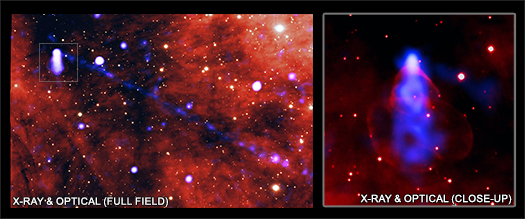Tiny Star Unleashes Gargantuan Beam of Matter and Antimatter

PSR J2030+4415
Credit: X-ray: NASA/CXC/Stanford Univ./M. de Vries; Optical: NSF/AURA/Gemini Consortium
This image from NASA's Chandra X-ray Observatory and ground-based optical telescopes shows an extremely long beam, or filament, of matter and antimatter extending from a relatively tiny pulsar, as reported in our latest press release. With its tremendous scale, this beam may help explain the surprisingly large numbers of positrons, the antimatter counterparts to electrons, scientists have detected throughout the Milky Way galaxy.
The panel on the left displays about one third the length of the beam from the pulsar known as PSR J2030+4415 (J2030 for short), which is located about 1,600 light years from Earth. J2030 is a dense, city-sized object that formed from the collapse of a massive star and currently spins about three times per second. X-rays from Chandra (blue) show where particles flowing from the pulsar along magnetic field lines are moving at about a third the speed of light. A close-up view of the pulsar in the right panel shows the X-rays created by particles flying around the pulsar itself. As the pulsar moves through space at about a million miles an hour, some of these particles escape and create the long filament. In both panels, optical light data from the Gemini telescope on Mauna Kea in Hawaii have been used and appear red, brown, and black. The full length of the filament is shown in a separate image.
The vast majority of the Universe consists of ordinary matter rather than antimatter. Scientists, however, continue to find evidence for relatively large numbers of positrons in detectors on Earth, which leads to the question: what are possible sources of this antimatter? The researchers in the new Chandra study of J2030 think that pulsars like it may be one answer. The combination of two extremes — fast rotation and high magnetic fields of pulsars — lead to particle acceleration and high energy radiation that creates electron and positron pairs. (The usual process of converting mass into energy famously determined by Einstein's E = mc2 equation is reversed, and energy is converted into mass.)
Pulsars generate winds of charged particles that are usually confined within their powerful magnetic fields. The pulsar is traveling through interstellar space at about half a million miles per hour, with the wind trailing behind it. A bow shock of gas moves along in front of the pulsar, similar to the pile-up of water in front of a moving boat. However, about 20 to 30 years ago the bow shock's motion appears to have stalled and the pulsar caught up to it.
The ensuing collision likely triggered a particle leak, where the pulsar wind's magnetic field linked up with the interstellar magnetic field. As a result, the high-energy electrons and positrons could have squirted out through a "nozzle" formed by connection into the Galaxy.
Previously, astronomers have observed large halos around nearby pulsars in gamma-ray light that imply energetic positrons generally have difficulty leaking out into the Galaxy. This undercut the idea that pulsars explain the positron excess that scientists detect. However, pulsar filaments that have recently been discovered, like J2030, show that particles actually can escape into interstellar space, and eventually could reach Earth.
A paper describing these results, authored by Martjin de Vries and Roger Romani of Stanford University, will appear in The Astrophysical Journal and is available online. NASA's Marshall Space Flight Center manages the Chandra program. The Smithsonian Astrophysical Observatory's Chandra X-ray Center controls science operations from Cambridge, Massachusetts, and flight operations from Burlington, Massachusetts.
Category:
- Log in to post comments
